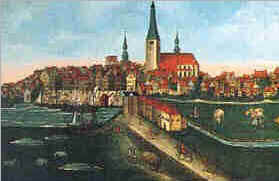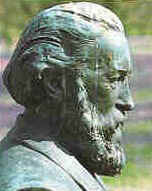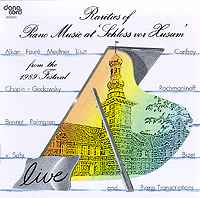The Festival of Rare Piano Music at Schloss vor Husum

OVERVIEW
There is no doubt that this is one of the most exciting
music festivals in the world. Perhaps there are some that are more famous
and a few that are more associated with big prizes and new careers than
this. However, the Festival of Rare Piano Music at Schloss vor Husum
fills a major gap in the musical life of Europe and, through the excellent
DANACORD CDs, the whole world.
Husum, itself, is in a relatively remote part of the
world close to the Danish border in the province of Schleswig-Holstein.
It lies on the North Sea and is renowned for its superb sea food (another
excellent reason for visiting the festival!). It is an attractive place
with lots of nooks and crannies to explore. And of course there is the
Schloss with its attractive gardens. They say that a million wild saffron
flowers grow here.

Husum is normally associated with the German poet and writer Theodor
Storm who was born here in 1817. In the middle of the nineteenth century
the town was under Danish rule. Storm, who at this time was a lawyer,
was minded to fight against this Danish rule and as a result lost his
job and his homeland. However brighter days were to come. After Germany
had reasserted itself on this disputed territory he returned to his
native heath as the Provincial Governor.
Storm’s poetry reflects the general greyness of the North Sea. It has
an air of sadness about it. He describes the place: - "it is only
a plain small town, my father’s city; it lies in a treeless coastal
plain and their houses are old and dark. I always regarded it nevertheless
as a pleasant place."
The thesis behind the piano festival was a desire to
go beyond the normal repertoire of most recitals heard these days. It
was an attempt to prove that it is possible to present a wide variety
of music by little known composers or little known music by the greats.
It was an endeavour to demonstrate that it is feasible to programme
works which do not conform to the accepted notions of what constitutes
a ‘traditional’ diet of a few well known pieces of ‘best-loved’ classics.
It was felt that it should be possible to present a
series of programmes that would appeal to the specialist in piano music
as well as to the average listener.
Danacord have produced a CD giving highlights of each
festival since 1989. There are thirteen of them so far. When one studies
the programmes of this cycle one is amazed at the sheer variety of works
presented. There is a procession of pieces ranging from a sonata movement
by Clementi through to a beautifully meditative work by John Cage. There
is every variety and style of music in-between.
One of the most interesting features of the Husum Festival
is the amount of time devoted to transcriptions, arrangements and paraphrases.
For so long this genre has been regarded as the Cinderella of piano
music. No self respecting concert programmer would include such works.
They were regarded as belonging to a past era. However we find here
that some of the most exciting performances are of arrangements. Tchaikowsky’s
Sugar Plum Fairy, Strauss’ Blue Danube and George Gershwin’s
‘The Man I Love’ all receive the transcriber’s sure touch. Some
of these are stunning re-workings of the originals. The stylistic range
is not limited to the frankly romantic. There are works by Zez Confrey,
Percy Grainger and as noted above Gershwin.
The technical range is tremendous. From some of the
most difficult ‘studies on studies’ by Godowsky-Chopin through to the
perfect simplicity of Abram Chasins arrangement of Gluck’s Melody
from Orpheus. There are miniatures and full-length sonatas here.
There is a cycle of Preludes by Scriabin through to the briefest
of encores by Selim Palmgren. Virtually every nationality of composer
is represented.
One of the joys of this collection is the continual
discovery of new material. Or perhaps it is an old favourite in an earlier
or later version. Or perhaps it is a new arrangement of a classic.
And the festival has been able to assemble an unbelievable
collection of pianists; some of the biggest names in the business have
come along to Husum to display their technique and repertoire.
REVIEW
Rarities of Piano Music at ‘ScHloss vor Husum from the
1989 Festival'

Charles-Valentin
Alkan:
[
l ] Cantique des cantiques (from "Preludes op. 31 ") 2:12
Ronald Smith
Sergei Rachmaninov: [ 2 ] Serenade
op. 3 No. 5 (rev. version) 2:28 Michael Ponti
Chopin - Godowsky: [ 3 ] Study No.
42 in a minor (after op. 25 No. 11) 4:17
Zez Confrey:[ 4 ] Kitten on the
Keys (1921) 2:15 Marc-André Hamelin
Heinrich von Sahr: From "Stimmen
der Nacht" op. 3 (1854) No. 2 [ 5 ] Larghetto, ma non troppo
3:29 Jozef De Beenhouwer
William Sterndale Bennett: [ 6 ]
Rondeau à la Polonaise op. 37 3:43
Nicolaj Medtner:[ 7 ] Fairy Tale
in c minor, op. 8 No. 2 6:16 Hamish Milne
Georges Bizet: [ 8 ] Depart
(from "Chants du Rhin", 1866) 2:28
Gabriel Faure: [ 9 ] Nocturne
No. 2 in B Major op. 33 No. 2 5:57 Jean-Marc Luisada
Gabriel Faure:[10] Nocturne No.
13 in b minor op. 119 8:24 Idil Biret
Faure - Grainger: [11] Nell op.
18 No. 1 ( 1924) 2:11
Selim Palmgren: [12] Feux-follets
op. 35 No. 3 (1912) 1:01 Peter Froundjian
Glinka - Balakirev:[13] The Lark
5:31
Tschaikowsky - Pletnjov:[14]
Andante maestoso (from "The Nutcracker") 5:58 Boris
Bloch
Franz Liszt:[15] Hungarian
Rhapsody No. 10 (1. Version) 5:43 Rainer M. Klaas
Gluck - Chasins: [16] Melody
(from "Orpheus") 3:25
Gershwin - Wild: [17] I got Rhythm(from
"Seven Virtuoso Etudes") 1:57 Daniel Berman
Recorded in Husum on August 19th –26th 1989
DANACORD DACOCD 349 [67 minutes]
Danacord
Ronald Smith opens the very first volume of
these Husum Festival recordings with a short piece by that prime example
of the forgotten composer. Busoni himself said that he was the ‘greatest
of the post-Beethoven piano composers. Charles Henri Alkan was
born in 1813 so being effectively a contemporary of Chopin, Liszt, Schumann
and Anton Rubinstein. He wrote a considerable number of works for the
piano. He composed in a very complex and often quite advanced style.
He was known as the ‘Berlioz of the Piano.’
The work played by Ronald Smith is the 13th
number from the collection of Preludes Opus 31. This was a series
of 25 pieces based on all major and minor keys. It was originally written
for either organ or piano with pedal board – something that had a minor
vogue in the nineteenth century. The last of the preludes is a prayer
– in the original key of C major. The Cantique de Cantiques (Song
of Songs) title given to the piece on the CD is actually a misnomer.
Its actual billing is ‘J’etais endormie, mais mon Coeur veillait…"
(I was asleep, but my heart watched)
This prelude was often played by Busoni in his recitals.
It is a quiet, almost mystical piece that allows the pianist to extract
a considerable degree of sensuousness from the piano. An excellent start.
Not a lot needs to be said about the life and works
of the pianist-composer Sergei Rachmaninov. The Serenade
is part of the early Opus 3.’Cinque Morceaux de Fantasie’. The Five
pieces were dedicated to the great Russian composer Anton Arensky who
was one of Rachmaninov’s professors at the Moscow Conservatoire. There
is a little story about this piece that bears telling. Originally there
were to have only been four Morceaux. However, Rachmaninov read
an interview that Tchaikovsky had given in the newspaper where the older
composer had suggested that Glazunov, Arensky and Rachmaninov were the
three outstanding composers of the younger generation. Sergei was so
pleased with this assessment that he "sat down at the piano and
composed a fifth piece." So that is how we have the Serenade.
This is a lovely piece of ‘salon’ music of the highest quality. It has
a definite Spanish feel to it. It is hardly a ‘discovery’ but Michael
Ponti’s playing makes it a pleasure to renew acquaintance with an
old favourite.
It is nice to see that Leopold Godowsky (1870-1938)
is making something of a comeback in the world of recordings. One of
the most gifted pianists of all time, he was able to translate his pianistic
technique into his transcriptions and original works. There are currently
two versions of the gigantic Piano Sonata available and two complete
cycles of the Studies on the Chopin Etudes.
If you have not heard these Studies based upon studies,
then you are in for a treat. For the original Chopin Etudes are fiendishly
difficult in their own right. But add the wizardry of Godowsky and we
see pianistic technique pushed to the limits. For example many of the
original studies – difficult for two hands- are reworked for left hand
alone. The entire compass of the piano is used; the use of the pedal
takes on a completely new character.
Marc-André Hamelin, who has recently
recorded the entire cycle, plays here the A minor Study No 42. This
is based on Chopin’s Opus 25 No.11, commonly known as the ‘Winter
Wind.’ This piece is set out for both hands – however the passagework
which Chopin gives to the right-hand is transferred to the left. We
have turbulent cascades of chromatic 16th notes. It pushes
the technique of the pianist to the limit. However Hamelin copes with
the problems admirably.
One of Marc Andre Hamelin’s encores was the fine ragtime
pieces by Zez Confrey (1895-1971) – ‘Kitten on the Keys.’(1921)
This is a great pieces of music by one of Americas lesser-known composers.
To my mind more satisfying, subtle and technically competent than Joplin
– it is similar in style to much that Billy Mayerl was to compose in
the United Kingdom. There are many other pieces in the Confrey catalogue
that are just dying for exposure – the Wise Cracker Suite and
the Moods of a New Yorker. Complementary music to the Godowsky,
indeed!
The pianist Jozef de Beenhouver played a piece
by the unknown composer Heinrich von Sahr. He chose the Larghetto
from the Stimmen der Nacht Op.3 (1854) This is a very quiet piece
and in some ways strangely modern in its sound considering the composer
was a friend of Beethoven. It allows the pianist to ‘tell a story’ in
a sustained and quite beautiful way.
Hamish Milne is a pianist with whom I associate
the collected works of Nicolai Medtner. He has produced one of
the two cycles of this relatively unknown composer’s complete piano
works. The other one is by Geoffrey Tozer on Chandos.
Medtner made a huge contribution to the piano repertoire.
There are some 14 sonatas, 33 Fairy Tales, three volumes
of Forgotten Melodies and some 40 Character Pieces.
The piece given here by Milne is the second one in
c minor from the Op. 8 ‘Two Fairy Tales.’ It is a complex work
with technical difficulties. Here we have rhythmic variety and a rich
palate of harmonic colours. There are few notes on the piano that are
not used!
William Sterndale Bennett (1816 –1875) is one
of those composers who has suffered from being compared to Felix Mendelssohn.
In fact he was known as the 'English Mendelssohn'. Of course there is
some justification in this comparison. He went to Leipzig to study composition.
Whilst there he befriended both the older composer and Richard Schumann.
There is no doubt in my own mind that he is severely underrated as part
of the heritage of English music. One only need to listen to the piano
concerti to see how competent he is in writing large scale works. His
music for solo piano is extensive. Much of it is quite attractive if
not profound. However, the Rondeau a la Polonaise is a relatively
obscure work – even to lovers of Sterndale Bennett’s music. It is a
lively work that shows an accomplished technique. Hamish Milne shows
off this music to advantage. It is time we re-appraised this practically
forgotten composer.
Jean-Marc Luisada plays a rarely heard example
of piano music by Georges Bizet – the Départ from
the ‘Chants du Rhin.’ This is quite obviously influenced by Mendelssohn
and Schumann. But so what – it is nice to hear something other than
Carmen and the Pearl Fishers from this French composer.
It is a beautifully stated 'song without words.' He actually wrote quite
a bit of piano music; one hopes that adventurous pianist will explore
it in a bit more depth.
I do not feel that I need say much about the two beautiful
Nocturnes by Gabriel Fauré. These works are relatively
familiar – although perhaps not as much played as they ought to be.
Luisada has chosen the delicious Op.33 No 2 in b major for his
recital and Idil Biret the much later Op.119 No.13 in b minor.
These are two attractive works that hold the listener’s attention. The
playing in both cases is quite magical. The harmonies of the later work
appear to be moving in a new direction - still tonal but beginning to
take on some of the colour of Claude Debussy.
Peter Froundjian was one of the instigators
and founders of this festival. And perhaps it is appropriate that he
should contribute two of the most interesting (if not the most profound)
works on this CD. The first piece recorded her is by that contemporary
of Sibelius, the Finnish composer Selim Palmgren (1878-1951).
Palmgren’s pianistic style is rooted firmly in the romantic nineteenth
century idiom. Of course he is not oblivious to developments in harmony
and melody. He has managed to produce what the programme notes describe
as a ‘will of the wisp’ sound in the Feux-follets from Op.35.
It all sounds very complex and the figurations are extremely involved.
Very short, lasting little over a minute, it has all the hallmarks of
a piece by Franz Liszt. A fair amount of Palmgren's music is available
on Finlandia and will repay careful listening.
The other piece played by Froundjian is the truly lovely
arrangement of the Fauré song ‘Nell’ the redoubtable
Percy Aldridge Grainger. Often we forget that Grainger was an accomplished
pianist who had studied with Ferrucio Busoni himself. He was always
on the lookout for attractive encores. This arrangement was published
in 1924 as apart of ‘Free Settings of Favourite Melodies.’ It
is a transcription of the highest order – a fine melody by Faure re-presented
by the virtuosity of Grainger. It is well played.
Four of the last five works on this CD are in fact
arrangements, paraphrases or transcriptions. The fifth work, played
by Rainer M. Klaas is an early redaction of the 10th
Hungarian Rhapsody by Franz Liszt. It is rarely heard in
this version; in fact this Rhapsody is perhaps less popular than the
ubiquitous 2nd. However, we discover an almost new work here.
It is as if the composer was deliberately writing a work that would
cause the maximum number of problems to the pianist. Every trick of
the trade here; massive chord, figurations and octaves all over the
place.
Boris Bloch plays two attractive transcriptions
by Balakirev and Pletnjov. The Lark originally
by Glinka and beautifully transcribed by Balakirev and even more magically
played by Bloch. The second one is the ‘famous bit’ from the Nutcracker
– the Pas de Deux. This is a wonderful arrangement – it is quite
definitely in the tradition of the Liszt and Thalberg operatic transcriptions.
It would make a fine encore at any recital – fiendishly difficult yet
truly beautiful.
The review of the festival on this CD concludes with
an arrangement of Gluck’s Melody from Orpheus by the American
composer Abram Chasins (1903-1987). This is almost ‘minimalistic’
in its rather hypnotic restful effect on the listener. Daniel Berman,
himself an American plays this piece with magic.
As a fine compliment to the earlier piece by Zez Confrey
we have an offering from George Gershwin – ‘I got rhythm’
as transcribed by the great classical pianist Earl Wild. What
a finish to this CD!
In conclusion this is an extremely well balanced CD
exploring many facets of the pianist repertoire. There is nothing here
that does not deserve to become better known in the recital rooms of
Europe and the United States.
All the pianists are masters of their craft. A fine
addition to the literature available on CD.
John France

